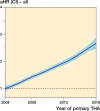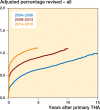Increasing risk of revision due to infection after primary total hip arthroplasty: results from the Nordic Arthroplasty Register Association
- PMID: 37378447
- PMCID: PMC10305062
- DOI: 10.2340/17453674.2023.13648
Increasing risk of revision due to infection after primary total hip arthroplasty: results from the Nordic Arthroplasty Register Association
Abstract
Background and purpose: The incidence of periprosthetic joint infection after total hip arthroplasty (THA) may be increasing. We performed time-trend analyses of risk, rates, and timing of revision due to infection after primary THAs in the Nordic countries from the period 2004-2018.
Patients and methods: 569,463 primary THAs reported to the Nordic Arthroplasty Register Association from 2004 to 2018 were studied. Absolute risk estimates were calculated by Kaplan-Meier and cumulative incidence function methods, whereas adjusted hazard ratios (aHR) were assessed by Cox regression with the first revision due to infection after primary THA as primary endpoint. In addition, we explored changes in the time span from primary THA to revision due to infection.
Results: 5,653 (1.0%) primary THAs were revised due to infection during a median follow-up time of 5.4 (IQR 2.5-8.9) years after surgery. Compared with the period 2004-2008, the aHRs for revision were 1.4 (95% confidence interval [CI] 1.3-1.5) for 2009-2013, and 1.9 (CI 1.7-2.0) for 2014-2018. The absolute 5-year rates of revision due to infection were 0.7% (CI 0.7-0.7), 1.0% (CI 0.9-1.0), and 1.2% (CI 1.2-1.3) for the 3 time periods respectively. We found changes in the time span from primary THA to revision due to infection. Compared with 2004-2008, the aHR for revision within 30 days after THA was 2.5 (CI 2.1-2.9) for 2009-2013, and 3.4 (CI 3.0-3.9) for 2013-2018. The aHR for revision within 31-90 days after THA was 1.5 (CI 1.3-1.9) for 2009-2013, and 2.5 (CI 2.1-3.0) for 2013-2018, compared with 2004-2008.
Conclusion: The risk of revision due to infection after primary THA almost doubled, both in absolute cumulative incidence and in relative risk, throughout the period 2004-2018. This increase was mainly due to an increased risk of revision within 90 days of THA. This may reflect a "true" increase (i.e., frailer patients or more use of uncemented implants) and/or an "apparent" increase (i.e., improved diagnostics, changed revision strategy, or completeness of reporting) in incidence of periprosthetic joint infection. It is not possible to disclose such changes in the present study, and this warrants further research.
Figures





References
-
- Brochin R L, Phan K, Poeran J, Zubizarreta N, Galatz L M, Moucha C S. Trends in periprosthetic hip infection and associated costs: a population-based study assessing the impact of hospital factors using national data. J Arthroplasty 2018; 33(7s): S233-s8. doi: 10.1016/j.arth.2018.02.062. - DOI - PubMed
-
- Kurtz S M, Lau E C, Son M S, Chang E T, Zimmerli W, Parvizi J. Are we winning or losing the battle with periprosthetic joint infection: trends in periprosthetic joint infection and mortality risk for the Medicare population. J Arthroplasty 2018; 33(10): 3238-45. doi: 10.1016/j.arth.2018.05.042. - DOI - PubMed
MeSH terms
LinkOut - more resources
Full Text Sources
Medical

